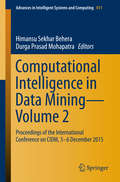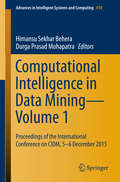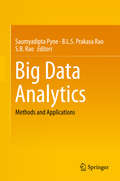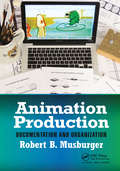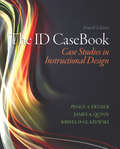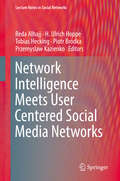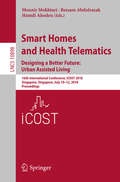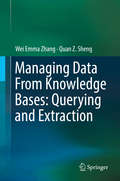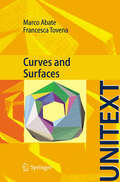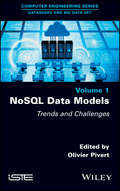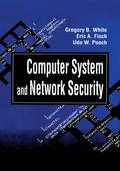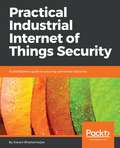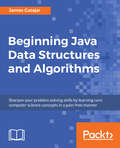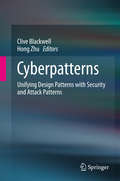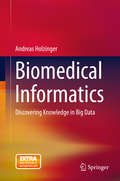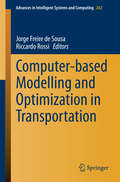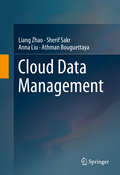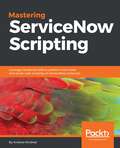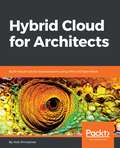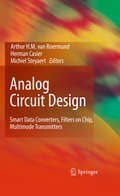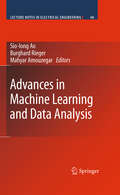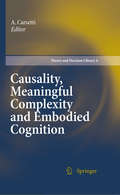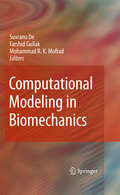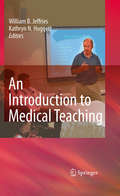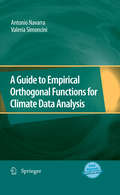- Table View
- List View
Computational Intelligence in Data Mining--Volume 1: Proceedings of the International Conference on CIDM, 5-6 December 2015 (Advances in Intelligent Systems and Computing #411)
by Himansu Sekhar Behera Durga Prasad MohapatraThe book is a collection of high-quality peer-reviewed research papers presented in the Second International Conference on Computational Intelligence in Data Mining (ICCIDM 2015) held at Bhubaneswar, Odisha, India during 5 - 6 December 2015. The two-volume Proceedings address the difficulties and challenges for the seamless integration of two core disciplines of computer science, i. e. , computational intelligence and data mining. The book addresses different methods and techniques of integration for enhancing the overall goal of data mining. The book helps to disseminate the knowledge about some innovative, active research directions in the field of data mining, machine and computational intelligence, along with some current issues and applications of related topics.
Computational Intelligence in Data Mining--Volume 1: Proceedings of the International Conference on CIDM, 5-6 December 2015 (Advances in Intelligent Systems and Computing #410)
by Himansu Sekhar Behera Durga Prasad MohapatraThe book is a collection of high-quality peer-reviewed research papers presented in the Second International Conference on Computational Intelligence in Data Mining (ICCIDM 2015) held at Bhubaneswar, Odisha, India during 5 - 6 December 2015. The two-volume Proceedings address the difficulties and challenges for the seamless integration of two core disciplines of computer science, i. e. , computational intelligence and data mining. The book addresses different methods and techniques of integration for enhancing the overall goal of data mining. The book helps to disseminate the knowledge about some innovative, active research directions in the field of data mining, machine and computational intelligence, along with some current issues and applications of related topics.
Big Data Analytics: Methods and Applications
by Saumyadipta Pyne B. L. S. Prakasa Rao S. B. RaoThis book has a collection of articles written by Big Data experts to describe some of the cutting-edge methods and applications from their respective areas of interest, and provides the reader with a detailed overview of the field of Big Data Analytics as it is practiced today. The chapters cover technical aspects of key areas that generate and use Big Data such as management and finance; medicine and healthcare; genome, cytome and microbiome; graphs and networks; Internet of Things; Big Data standards; bench-marking of systems; and others. In addition to different applications, key algorithmic approaches such as graph partitioning, clustering and finite mixture modelling of high-dimensional data are also covered. The varied collection of themes in this volume introduces the reader to the richness of the emerging field of Big Data Analytics.
Animation Production: Documentation and Organization
by Robert B. MusburgerThis text follows the animation production by concentrating on the documentation necessary to accurately and professionally organize each step of the process. Examples of each piece of paperwork needed to complete the project will be shown. Many newcomers to the field are not experienced in the basic processes to organize their project in an orderly manner. The result is a chaotic, inefficient, and incomplete product. Readers are presented with a step-by-step guide to organizing the process by following professional standards in creating needed and useful documentation for all animators, whether creating in cells, stop-motion, experimental, or computer graphic productions.
The ID CaseBook: Case Studies in Instructional Design
by Peggy A. Ertmer James A. Quinn Krista D. GlazewskiFirst Published in 2017. Routledge is an imprint of Taylor & Francis, an Informa company.The Fourth Edition of this highly regarded problem-solving text presents 30 realistic case studies in a wide range of authentic contexts, from K-12 to post-secondary, corporate, and manufacturing. The cases and their accompanying discussion questions encourage ID students to analyze the available information, develop conclusions, and consider alternative possibilities in resolving ID problems.
Network Intelligence Meets User Centered Social Media Networks (Lecture Notes in Social Networks)
by Reda Alhajj H. Ulrich Hoppe Tobias Hecking Piotr Bródka Przemyslaw KazienkoThis edited volume presents advances in modeling and computational analysis techniques related to networks and online communities. It contains the best papers of notable scientists from the 4th European Network Intelligence Conference (ENIC 2017) that have been peer reviewed and expanded into the present format. The aim of this text is to share knowledge and experience as well as to present recent advances in the field. The book is a nice mix of basic research topics such as data-based centrality measures along with intriguing applied topics, for example, interaction decay patterns in online social communities. This book will appeal to students, professors, and researchers working in the fields of data science, computational social science, and social network analysis.
Smart Homes and Health Telematics, Designing a Better Future: 16th International Conference, ICOST 2018, Singapore, Singapore, July 10-12, 2018, Proceedings (Lecture Notes in Computer Science #10898)
by Mounir Mokhtari Bessam Abdulrazak Hamdi AloulouThis book constitutes the proceedings of the 16th International Conference on Smart Homes and Health Telematics, ICOST 2018, held in Singapore, Singapore, in July 2018. The theme of this year volume is "Designing a better Future: Urban Assisted Living", focusing on quality of life of dependent people not only in their homes, but also in outdoor living environment to improve mobility and social interaction in the city. The 21 regular papers and 11 short papers included in this volume focus on research in the design, development, deployment and evaluation of smart urban environments, assistive technologies, chronic disease management, coaching and health telematics systems.
Managing Data From Knowledge Bases: Querying and Extraction
by Wei Emma Zhang Quan Z. ShengIn this book, the authors first address the research issues by providing a motivating scenario, followed by the exploration of the principles and techniques of the challenging topics. Then they solve the raised research issues by developing a series of methodologies. More specifically, the authors study the query optimization and tackle the query performance prediction for knowledge retrieval. They also handle unstructured data processing, data clustering for knowledge extraction. To optimize the queries issued through interfaces against knowledge bases, the authors propose a cache-based optimization layer between consumers and the querying interface to facilitate the querying and solve the latency issue. The cache depends on a novel learning method that considers the querying patterns from individual’s historical queries without having knowledge of the backing systems of the knowledge base. To predict the query performance for appropriate query scheduling, the authors examine the queries’ structural and syntactical features and apply multiple widely adopted prediction models. Their feature modelling approach eschews the knowledge requirement on both the querying languages and system. To extract knowledge from unstructured Web sources, the authors examine two kinds of Web sources containing unstructured data: the source code from Web repositories and the posts in programming question-answering communities. They use natural language processing techniques to pre-process the source codes and obtain the natural language elements. Then they apply traditional knowledge extraction techniques to extract knowledge. For the data from programming question-answering communities, the authors make the attempt towards building programming knowledge base by starting with paraphrase identification problems and develop novel features to accurately identify duplicate posts. For domain specific knowledge extraction, the authors propose to use clustering technique to separate knowledge into different groups. They focus on developing a new clustering algorithm that uses manifold constraint in the optimization task and achieves fast and accurate performance. For each model and approach presented in this dissertation, the authors have conducted extensive experiments to evaluate it using either public dataset or synthetic data they generated.
Curves and Surfaces (UNITEXT)
by M. Abate F. TovenaThe book provides an introduction to Differential Geometry of Curves and Surfaces. The theory of curves starts with a discussion of possible definitions of the concept of curve, proving in particular the classification of 1-dimensional manifolds. We then present the classical local theory of parametrized plane and space curves (curves in n-dimensional space are discussed in the complementary material): curvature, torsion, Frenet's formulas and the fundamental theorem of the local theory of curves. Then, after a self-contained presentation of degree theory for continuous self-maps of the circumference, we study the global theory of plane curves, introducing winding and rotation numbers, and proving the Jordan curve theorem for curves of class C2, and Hopf theorem on the rotation number of closed simple curves. The local theory of surfaces begins with a comparison of the concept of parametrized (i.e., immersed) surface with the concept of regular (i.e., embedded) surface. We then develop the basic differential geometry of surfaces in R3: definitions, examples, differentiable maps and functions, tangent vectors (presented both as vectors tangent to curves in the surface and as derivations on germs of differentiable functions; we shall consistently use both approaches in the whole book) and orientation. Next we study the several notions of curvature on a surface, stressing both the geometrical meaning of the objects introduced and the algebraic/analytical methods needed to study them via the Gauss map, up to the proof of Gauss' Teorema Egregium. Then we introduce vector fields on a surface (flow, first integrals, integral curves) and geodesics (definition, basic properties, geodesic curvature, and, in the complementary material, a full proof of minimizing properties of geodesics and of the Hopf-Rinow theorem for surfaces). Then we shall present a proof of the celebrated Gauss-Bonnet theorem, both in its local and in its global form, using basic properties (fully proved in the complementary material) of triangulations of surfaces. As an application, we shall prove the Poincaré-Hopf theorem on zeroes of vector fields. Finally, the last chapter will be devoted to several important results on the global theory of surfaces, like for instance the characterization of surfaces with constant Gaussian curvature, and the orientability of compact surfaces in R3.
NoSQL Data Models: Trends and Challenges
by Olivier PivertThe topic of NoSQL databases has recently emerged, to face the Big Data challenge, namely the ever increasing volume of data to be handled. It is now recognized that relational databases are not appropriate in this context, implying that new database models and techniques are needed. This book presents recent research works, covering the following basic aspects: semantic data management, graph databases, and big data management in cloud environments. The chapters in this book report on research about the evolution of basic concepts such as data models, query languages, and new challenges regarding implementation issues.
Computer System and Network Security (Computer Science & Engineering #7)
by Gregory B. White Eric A. Fisch Udo W. PoochComputer System and Network Security provides the reader with a basic understanding of the issues involved in the security of computer systems and networks. Introductory in nature, this important new book covers all aspects related to the growing field of computer security. Such complete coverage in a single text has previously been unavailable, and college professors and students, as well as professionals responsible for system security, will find this unique book a valuable source of information, either as a textbook or as a general reference. Computer System and Network Security discusses existing and potential threats to computer systems and networks and outlines the basic actions that are generally taken to protect them. The first two chapters of the text introduce the reader to the field of computer security, covering fundamental issues and objectives. The next several chapters describe security models, authentication issues, access control, intrusion detection, and damage control. Later chapters address network and database security and systems/networks connected to wide-area networks and internetworks. Other topics include firewalls, cryptography, malicious software, and security standards. The book includes case studies with information about incidents involving computer security, illustrating the problems and potential damage that can be caused when security fails.This unique reference/textbook covers all aspects of computer and network security, filling an obvious gap in the existing literature.
Practical Industrial Internet of Things Security: A practitioner's guide to securing connected industries
by Sravani BhattacharjeeSkillfully navigate through the complex realm of implementing scalable, trustworthy industrial systems and architectures in a hyper-connected business world.Key FeaturesGain practical insight into security concepts in the Industrial Internet of Things (IIoT) architectureDemystify complex topics such as cryptography and blockchainComprehensive references to industry standards and security frameworks when developing IIoT blueprintsBook DescriptionSecuring connected industries and autonomous systems is a top concern for the Industrial Internet of Things (IIoT) community. Unlike cybersecurity, cyber-physical security is an intricate discipline that directly ties to system reliability as well as human and environmental safety. Practical Industrial Internet of Things Security enables you to develop a comprehensive understanding of the entire spectrum of securing connected industries, from the edge to the cloud.This book establishes the foundational concepts and tenets of IIoT security by presenting real-world case studies, threat models, and reference architectures. You’ll work with practical tools to design risk-based security controls for industrial use cases and gain practical know-how on the multi-layered defense techniques including Identity and Access Management (IAM), endpoint security, and communication infrastructure. Stakeholders, including developers, architects, and business leaders, can gain practical insights in securing IIoT lifecycle processes, standardization, governance and assess the applicability of emerging technologies, such as blockchain, Artificial Intelligence, and Machine Learning, to design and implement resilient connected systems and harness significant industrial opportunities.What you will learnUnderstand the crucial concepts of a multi-layered IIoT security frameworkGain insight on securing identity, access, and configuration management for large-scale IIoT deploymentsSecure your machine-to-machine (M2M) and machine-to-cloud (M2C) connectivityBuild a concrete security program for your IIoT deploymentExplore techniques from case studies on industrial IoT threat modeling and mitigation approachesLearn risk management and mitigation planningWho this book is forPractical Industrial Internet of Things Security is for the IIoT community, which includes IIoT researchers, security professionals, architects, developers, and business stakeholders. Anyone who needs to have a comprehensive understanding of the unique safety and security challenges of connected industries and practical methodologies to secure industrial assets will find this book immensely helpful. This book is uniquely designed to benefit professionals from both IT and industrial operations backgrounds.
Beginning Java Data Structures and Algorithms: Sharpen your problem solving skills by learning core computer science concepts in a pain-free manner
by James CutajarThough your application serves its purpose, it might not be a high performer. Learn techniques to accurately predict code efficiency, easily dismiss inefficient solutions, and improve the performance of your application.Key FeaturesExplains in detail different algorithms and data structures with sample problems and Java implementations where appropriateIncludes interesting tips and tricks that enable you to efficiently use algorithms and data structuresCovers over 20 topics using 15 practical activities and exercises Book DescriptionLearning about data structures and algorithms gives you a better insight on how to solve common programming problems. Most of the problems faced everyday by programmers have been solved, tried, and tested. By knowing how these solutions work, you can ensure that you choose the right tool when you face these problems.This book teaches you tools that you can use to build efficient applications. It starts with an introduction to algorithms and big O notation, later explains bubble, merge, quicksort, and other popular programming patterns. You’ll also learn about data structures such as binary trees, hash tables, and graphs. The book progresses to advanced concepts, such as algorithm design paradigms and graph theory. By the end of the book, you will know how to correctly implement common algorithms and data structures within your applications.What you will learnUnderstand some of the fundamental concepts behind key algorithmsExpress space and time complexities using Big O notation.Correctly implement classic sorting algorithms such as merge and quicksortCorrectly implement basic and complex data structuresLearn about different algorithm design paradigms, such as greedy, divide and conquer, and dynamic programmingApply powerful string matching techniques and optimize your application logicMaster graph representations and learn about different graph algorithmsWho this book is forIf you want to better understand common data structures and algorithms by following code examples in Java and improve your application efficiency, then this is the book for you. It helps to have basic knowledge of Java, mathematics and object-oriented programming techniques.
Cyberpatterns: Unifying Design Patterns with Security and Attack Patterns
by Clive Blackwell Hong ZhuCyberspace in increasingly important to people in their everyday lives for purchasing goods on the Internet, to energy supply increasingly managed remotely using Internet protocols. Unfortunately, this dependence makes us susceptible to attacks from nation states, terrorists, criminals and hactivists. Therefore, we need a better understanding of cyberspace, for which patterns, which are predictable regularities, may help to detect, understand and respond to incidents better. The inspiration for the workshop came from the existing work on formalising design patterns applied to cybersecurity, but we also need to understand the many other types of patterns that arise in cyberspace.
Biomedical Informatics: Discovering Knowledge in Big Data (Lecture Notes in Computer Science #8401)
by Andreas HolzingerThis book provides a broad overview of the topic Bioinformatics with focus on data, information and knowledge. From data acquisition and storage to visualization, ranging through privacy, regulatory and other practical and theoretical topics, the author touches several fundamental aspects of the innovative interface between Medical and Technology domains that is Biomedical Informatics. Each chapter starts by providing a useful inventory of definitions and commonly used acronyms for each topic and throughout the text, the reader finds several real-world examples, methodologies and ideas that complement the technical and theoretical background This new edition includes new sections at the end of each chapter, called "future outlook and research avenues," providing pointers to future challenges. At the beginning of each chapter a new section called "key problems", has been added, where the author discusses possible traps and unsolvable or major problems
Computer-based Modelling and Optimization in Transportation (Advances in Intelligent Systems and Computing #262)
by Jorge Freire Sousa Riccardo RossiThis volume brings together works resulting from research carried out by members of the EURO Working Group on Transportation (EWGT) and presented during meetings and workshops organized by the Group under the patronage of the Association of European Operational Research Societies in 2012 and 2013. The main targets of the EWGT include providing a forum to share research information and experience, encouraging joint research and the development of both theoretical methods and applications, and promoting cooperation among the many institutions and organizations which are leaders at national level in the field of transportation and logistics. The primary fields of interest concern operational research methods, mathematical models and computation algorithms, to solve and sustain solutions to problems mainly faced by public administrations, city authorities, public transport companies, service providers and logistic operators. Related areas of interest are: land use and transportation planning, traffic control and simulation models, traffic network equilibrium models, public transport planning and management, applications of combinatorial optimization, vehicle routing and scheduling, intelligent transport systems, logistics and freight transport, environment problems, transport safety, and impact evaluation methods. In this volume, attention focuses on the following topics of interest: · Decision-making and decision support · Energy and Environmental Impacts · Urban network design · Optimization and simulation · Traffic Modelling, Control and Network Traffic Management · Transportation Planning · Mobility, Accessibility and Travel Behavior · Vehicle Routing
Cloud Data Management
by Sherif Sakr Athman Bouguettaya Liang Zhao Anna LiuIn practice, the design and architecture of a cloud varies among cloud providers. We present a generic evaluation framework for the performance, availability and reliability characteristics of various cloud platforms. We describe a generic benchmark architecture for cloud databases, specifically NoSQL database as a service. It measures the performance of replication delay and monetary cost. Service Level Agreements (SLA) represent the contract which captures the agreed upon guarantees between a service provider and its customers. The specifications of existing service level agreements (SLA) for cloud services are not designed to flexibly handle even relatively straightforward performance and technical requirements of consumer applications. We present a novel approach for SLA-based management of cloud-hosted databases from the consumer perspective and an end-to-end framework for consumer-centric SLA management of cloud-hosted databases. The framework facilitates adaptive and dynamic provisioning of the database tier of the software applications based on application-defined policies for satisfying their own SLA performance requirements, avoiding the cost of any SLA violation and controlling the monetary cost of the allocated computing resources. In this framework, the SLA of the consumer applications are declaratively defined in terms of goals which are subjected to a number of constraints that are specific to the application requirements. The framework continuously monitors the application-defined SLA and automatically triggers the execution of necessary corrective actions (scaling out/in the database tier) when required. The framework is database platform-agnostic, uses virtualization-based database replication mechanisms and requires zero source code changes of the cloud-hosted software applications.
Mastering ServiceNow Scripting: Leverage JavaScript APIs to perform client-side and server-side scripting on ServiceNow instances
by Andrew KindredUnderstand the ServiceNow scripting and build an efficient customized ServiceNow instance Key Features Customize your ServiceNow instance according to your organization’s needs Learn to work with inbuilt JavaScript APIs in ServiceNow Take your ServiceNow experience to the next level by learning to script Book Description Industry giants like RedHat and NetApp have adopted ServiceNow for their operational needs, and it is evolving as the number one platform choice for IT Service management. ServiceNow provides their clients with an add-on when it comes to baseline instances, where scripting can be used to customize and improve the performance of instances. It also provides inbuilt JavaScript API for scripting and improving your JavaScript instance. This book will initially cover the basics of ServiceNow scripting and the appropriate time to script in a ServiceNow environment. Then, we dig deeper into client-side and server-side scripting using JavaScipt API. We will also cover advance concepts like on-demand functions, script actions, and best practices. Mastering ServiceNow Scripting acts as an end-to-end guide for writing, testing, and debugging scripts of ServiceNow. We cover update sets for moving customizations between ServiceNow instances, jelly scripts for making custom pages, and best practices for all types of script in ServiceNow. By the end of this book, you will have hands-on experience in scripting ServiceNow using inbuilt JavaScript API. What you will learn Customize your ServiceNow instance according to your organization's needs Explore the ServiceNow-exposed JavaScript APIs and libraries Discover the method for using ServiceNow scripting functions Take your ServiceNow experience to the next level by understanding advanced scripting Learn to build, test, and debug custom applications Use your customized instance efficiently with the help of best practices Who this book is for This book is targeted toward ServiceNow administrators or anyone willing to learn inbuilt JavaScript APIs used to script and customize ServiceNow instances. Prior experience with ServiceNow is required.
Hybrid Cloud for Architects: Build robust hybrid cloud solutions using AWS and OpenStack
by David Duncan Alok ShrivastwaBuild your own hybrid cloud strategy with this comprehensive learning guide. Key Features Build a hybrid cloud strategy for your organization with AWS and OpenStack Leverage Hybrid Cloud to design a complex deployment pipeline Learn to implement security and monitoring best practices with real-world examples Book Description Hybrid cloud is currently the buzz word in the cloud world. Organizations are planning to adopt hybrid cloud strategy due to its advantages such as untested workloads, cloud-bursting, cloud service brokering and so on. This book will help you understand the dynamics, design principles, and deployment strategies of a Hybrid Cloud. You will start by understanding the concepts of hybrid cloud and the problems it solves as compared to a stand-alone public and private cloud. You will be delving into the different architecture and design of hybrid cloud. The book will then cover advanced concepts such as building a deployment pipeline, containerization strategy, and data storage mechanism. Next up, you will be able to deploy an external CMP to run a Hybrid cloud and integrate it with your OpenStack and AWS environments. You will also understand the strategy for designing a Hybrid Cloud using containerization and work with pre-built solutions like vCloud Air, VMware for AWS, and Azure Stack. Finally, the book will cover security and monitoring related best practices that will help you secure your cloud infrastructure. By the end of the book, you will be in a position to build a hybrid cloud strategy for your organization. What you will learn Learn the demographics and definitions of Hybrid Cloud Understand the different architecture and design of Hybrid Cloud Explore multi-cloud strategy and use it with your hybrid cloud Implement a Hybrid Cloud using CMP / Common API’s Implement a Hybrid Cloud using Containers Overcome various challenges and issues while working with your Hybrid Cloud Understand how to monitor your Hybrid Cloud Discover the security implications in the Hybrid CloudWho this book is for This book is targeted at cloud architects, cloud solution providers, DevOps engineers, or any working stakeholder who wants to learn about the hybrid cloud architecture. A basic understanding of public and private cloud is desirable.
Analog Circuit Design: Smart Data Converters, Filters on Chip, Multimode Transmitters (Analog Circuit Design Ser.)
by Michiel Steyaert Arthur H.M. Roermund Herman CasierAnalog Circuit Design contains the contribution of 18 tutorials of the 18th workshop on Advances in Analog Circuit Design. Each part discusses a specific to-date topic on new and valuable design ideas in the area of analog circuit design. Each part is presented by six experts in that field and state of the art information is shared and overviewed. This book is number 18 in this successful series of Analog Circuit Design, providing valuable information and excellent overviews of: Smart Data Converters: Chaired by Prof. Arthur van Roermund, Eindhoven University of Technology, Filters on Chip: Chaired by Herman Casier, AMI Semiconductor Fellow, Multimode Transmitters: Chaired by Prof. M. Steyaert, Catholic University Leuven, Analog Circuit Design is an essential reference source for analog circuit designers and researchers wishing to keep abreast with the latest development in the field. The tutorial coverage also makes it suitable for use in an advanced design.
Advances in Machine Learning and Data Analysis (Lecture Notes in Electrical Engineering #48)
by Mahyar AmouzegarA large international conference on Advances in Machine Learning and Data Analysis was held in UC Berkeley, California, USA, October 22-24, 2008, under the auspices of the World Congress on Engineering and Computer Science (WCECS 2008). This volume contains sixteen revised and extended research articles written by prominent researchers participating in the conference. Topics covered include Expert system, Intelligent decision making, Knowledge-based systems, Knowledge extraction, Data analysis tools, Computational biology, Optimization algorithms, Experiment designs, Complex system identification, Computational modeling, and industrial applications. Advances in Machine Learning and Data Analysis offers the state of the art of tremendous advances in machine learning and data analysis and also serves as an excellent reference text for researchers and graduate students, working on machine learning and data analysis.
Causality, Meaningful Complexity and Embodied Cognition (Theory and Decision Library A: #46)
by A. CarsettiWith respect to the possible outlining of new models of the process of knowledge construction, we are really faced, at the moment, with the appearance of a new frontier: a frontier that appears strictly linked to the emergence of a conceptual revolution at the level of the analysis of that peculiar entanglement of complexity, information, causality, meaning, emergence, teleology and intentionality that characterizes the unfolding of the "natural forms" of human cognition. To recognize some of the peculiar knots of this particular conceptual revolution precisely constitutes the first target of the volume. Cognitive activity is rooted in Reality, but at the same time represents the necessary means whereby Reality can embody itself in an objective way: i.e., in accordance with an in-depth nesting process and a surface unfolding of operational meaning. In this sense, the objectivity of Reality is also proportionate to the autonomy reached by cognitive processes. Within this conceptual framework, reference procedures thus appear as related to the modalities providing the successful constitution of the channel, of the actual link, in particular, established at the neural level between operations of vision and thought. Such procedures ensure not a simple "regimentation" or an adequate replica, but, on the contrary, the real constitution of a cognitive autonomy in accordance with the truth. A method thus emerges which is simultaneously project, telos and regulating activity: a code that becomes process, positing itself as the foundation of a constantly renewed synthesis between function and meaning. In this sense, at the level of cultural evolution, reference procedures act as guide, mirror and canalisation with respect to primary information flows and involved selective forces. They also constitute a precise support for the operations which "imprison" meaning and "inscribe" the "file" considered as an autonomous categorial (and generating) system. In this way, they offer themselves as the actual instruments for the constant renewal of the code, for the invention and the actual articulation of an ever-new incompressibility.
Computational Modeling in Biomechanics
by Suvranu De Farshid Guilak Mohammad MofradAvailability of advanced computational technology has fundamentally altered the investigative paradigm in the field of biomechanics. Armed with sophisticated computational tools, researchers are seeking answers to fundamental questions by exploring complex biomechanical phenomena at the molecular, cellular, tissue and organ levels. The computational armamentarium includes such diverse tools as the ab initio quantum mechanical and molecular dynamics methods at the atomistic scales and the finite element, boundary element, meshfree as well as immersed boundary and lattice-Boltzmann methods at the continuum scales. Multiscale methods that link various scales are also being developed. While most applications require forward analysis, e.g., finding deformations and stresses as a result of loading, others involve determination of constitutive parameters based on tissue imaging and inverse analysis. This book provides a glimpse of the diverse and important roles that modern computational technology is playing in various areas of biomechanics including biofluids and mass transfer, cardiovascular mechanics, musculoskeletal mechanics, soft tissue mechanics, and biomolecular mechanics.
An Introduction to Medical Teaching
by William B. Jeffries Kathryn HuggettFew faculty members in academic medical centres are formally prepared for their roles as teachers. This work is an introductory text designed to provide medical teachers with the core concepts of effective teaching practice and information about innovations for curriculum design, delivery, and assessment. It offers brief, focused chapters with content that is easily assimilated by the reader. Topics are relevant to basic science and clinical teachers, and the work does not presume readers possess prerequisite knowledge of education theory or instructional design. The authors emphasize application of concepts to teaching practice. Topics include: Helping Students Learn; Teaching Large Groups; Teaching in Small Groups; Problem Based Learning; Team-Based Learning, Teaching Clinical Skills; Teaching with Simulation; Teaching with Practicals and Labs; Teaching with Technological Tools; Designing a Course; Assessing Student Performance; Documenting the Trajectory of your Teaching and Teaching as Scholarship. Chapters were written by leaders in medical education and research who draw upon extensive professional experience and the literature on best practices in education. Although designed for teachers, the work reflects a learner-centred perspective and emphasizes outcomes for student learning. The book is accessible and visually interesting, and the work contains information that is current, but not time-sensitive. The work includes recommendations for additional reading and an appendix with resources for medical education.
A Guide to Empirical Orthogonal Functions for Climate Data Analysis
by Valeria Simoncini Antonio NavarraClimatology and meteorology have basically been a descriptive science until it became possible to use numerical models, but it is crucial to the success of the strategy that the model must be a good representation of the real climate system of the Earth. Models are required to reproduce not only the mean properties of climate, but also its variability and the strong spatial relations between climate variability in geographically diverse regions. Quantitative techniques were developed to explore the climate variability and its relations between different geographical locations. Methods were borrowed from descriptive statistics, where they were developed to analyze variance of related observations-variable pairs, or to identify unknown relations between variables. A Guide to Empirical Orthogonal Functions for Climate Data Analysis uses a different approach, trying to introduce the reader to a practical application of the methods, including data sets from climate simulations and MATLAB codes for the algorithms. All pictures and examples used in the book may be reproduced by using the data sets and the routines available in the book . Though the main thrust of the book is for climatological examples, the treatment is sufficiently general that the discussion is also useful for students and practitioners in other fields. Supplementary datasets are available via http://extra.springer.com
